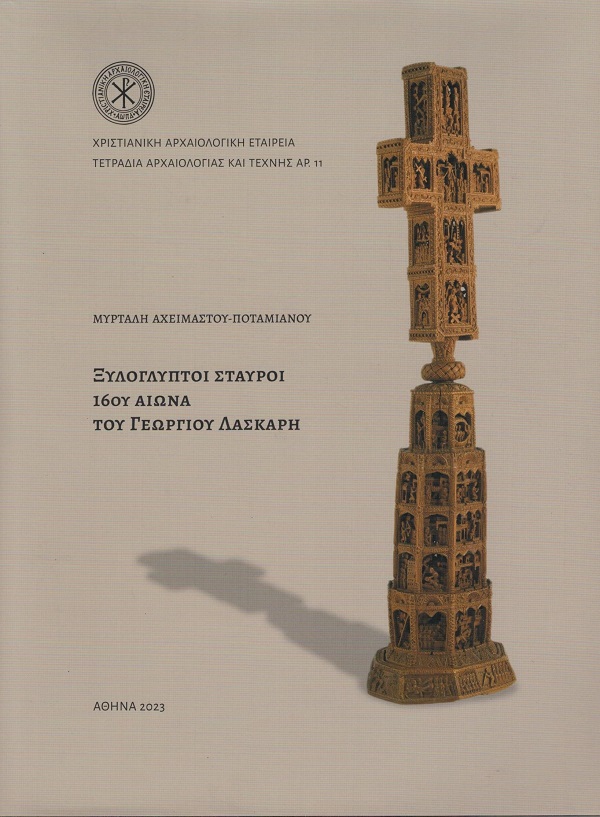Myrtali Acheimastou-Potamianou, Wood carved crosses of the 16th Century by George Laskaris (testo in greco e inglese), 212 pagine formato cm. 29 x 23, Christian Archeological Society, Studies of Archeology and Art n. 11, Athens 2003 (ISBN: 978-618-85074-1-8).
(English version below)
Ci rivolgiamo a quei pochi, ma non pochissimi, che conoscono questa particolare tipologia di croci di cui abbiamo parlato nell’articolo Una croce di Giorgio Lascaris nella Collezione Cagnola (aprile 2013 [ Leggi ].
In questi dieci anni ci sono pervenute numerose richieste di approfondimenti e qualche segnalazione di nuovi esemplari, nonché ci sono stati contatti con studiosi come nel caso della professoressa Myrtali Acheimastou-Potamianou che firma questo bel volume.
Lo studio è prevalentemente incentrato su due croci inedite che si trovano in Grecia – la prima ad Atene in una collezione privata (proveniente dal mercato antiquario olandese) e la seconda ad Argostoli, nell’isola di Cefalonia, presso il Museo Corjialenios – e che si sommano alle 16 croci datate finora note che coprono un arco di tempo che va dal 1538 al 1583. Di queste, otto recano la firma dell’ancora misterioso intagliatore Giorgio Lascaris che le esegue tra il 1551 e il 1538.
Alle croci firmate e datate e a quelle solo datate se ne aggiungono altre per un totale di circa 30.
Oltre ad analizzare puntualmente le due croci greche, sia dal punto di vista iconografico sia dell’interpretazione delle scritte a rilievo che fanno da “didascalia” alle immagini, facendo confronti con alcuni esemplari già noti, lo studio ha il merito di suggerire, per la prima volta, che Giorgio Lascaris abbia svolto la sua attività non sul monte Athos, come ritenuto da più parti, bensì a Creta e più precisamente a Chandax (l’attuale Heraklion).
Il testo è in lingua greca, ma è stato tradotto pressoché interamente in inglese.
La prefazione di cui alle pagine 11 e 12 è tradotta alle pagine 157 e 150, mentre il testo principale (pp. 23-73) è tradotto integralmente alle pagine da 159 a 208.
Al centro, troviamo le immagini della croce in collezione privata ateniese datata 1555 (figg. 1-25), di quella di Argostoli, datata 1582 (figg. 26-49) e di altre 6 croci (figg. 50-83), tutte corredate da didascalie in greco e inglese. Mancano alla traduzione solo la bibliografia e l’indice dei nomi.
Il volume non risulta attualmente disponibile sul mercato nazionale; lo si può richiedere direttamente alla Christian Archeological Society (Società Archeologica Cristiana) di Atene:
chae.secretary@gmail.com
www.chae.gr
We are addressing those few, but not very few, who know this particular type of cross we talked about in the article Una croce di Giorgio Lascaris nella Collezione Cagnola (A cross by Giorgio Lascaris in the Cagnola Collection) (April 2013 [ Read ].
In these ten years we have received numerous requests for further information and some reports of new specimens, as well as contacts with scholars as in the case of Professor Myrtali Acheimastou-Potamianou who signs this beautiful volume.
The study is mainly focused on two unpublished crosses found in Greece – the first in Athens in a private collection (coming from the Dutch antiques market) and the second in Argostoli, on the island of Kefalonia, at the Corjialenios Museum – and which add up to the 16 dated crosses known so far which cover a period of time ranging from 1538 to 1583. Of these, eight bear the signature of the still mysterious engraver Giorgio Lascaris who executed them between 1551 and 1538.
The signed and dated crosses and those only dated are joined by others for a total of about 30.
In addition to punctually analyzing the two Greek crosses, both from an iconographic point of view and from the interpretation of the relief writings that act as “captions” to the images, making comparisons with some already known specimens, the study has the merit of suggesting, for the first time, that Giorgio Lascaris carried out his activity not on Mount Athos, as believed by many, but in Crete and more precisely in Chandax (present-day Heraklion).
The text is in Greek, but has been translated almost entirely into English.
The preface on pages 11 and 12 is translated on pages 157 and 150, while the main text (pp. 23-73) is translated in full on pages 159 to 208.
In the centre, we find the images of the cross dated 1555 in an Athenian private collection (figs. 1-25), of that of Argostoli, dated 1582 (figs. 26-49) and of 6 other crosses (figs. 50-83), all accompanied by captions in Greek and English. Only the bibliography and the index of names are missing from the translation.
The volume is not currently available on the national market; it can be requested directly from the Christian Archaeological Society of Athens:
chae.secretary@gmail.com
www.chae.gr

